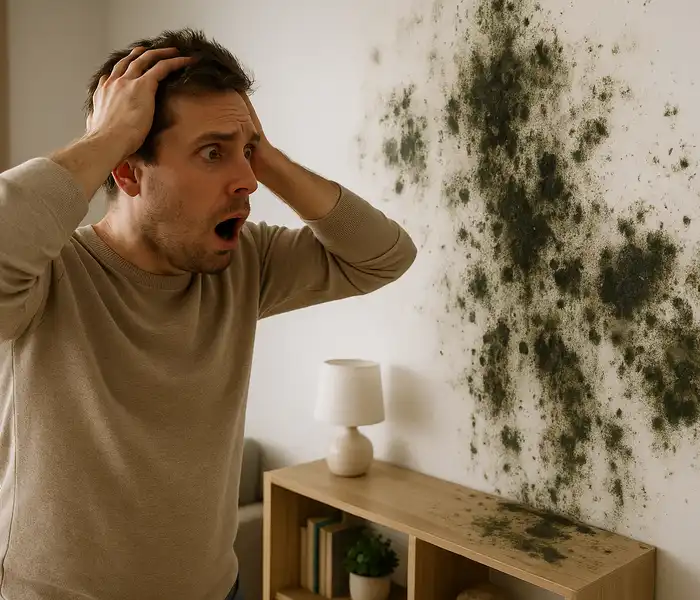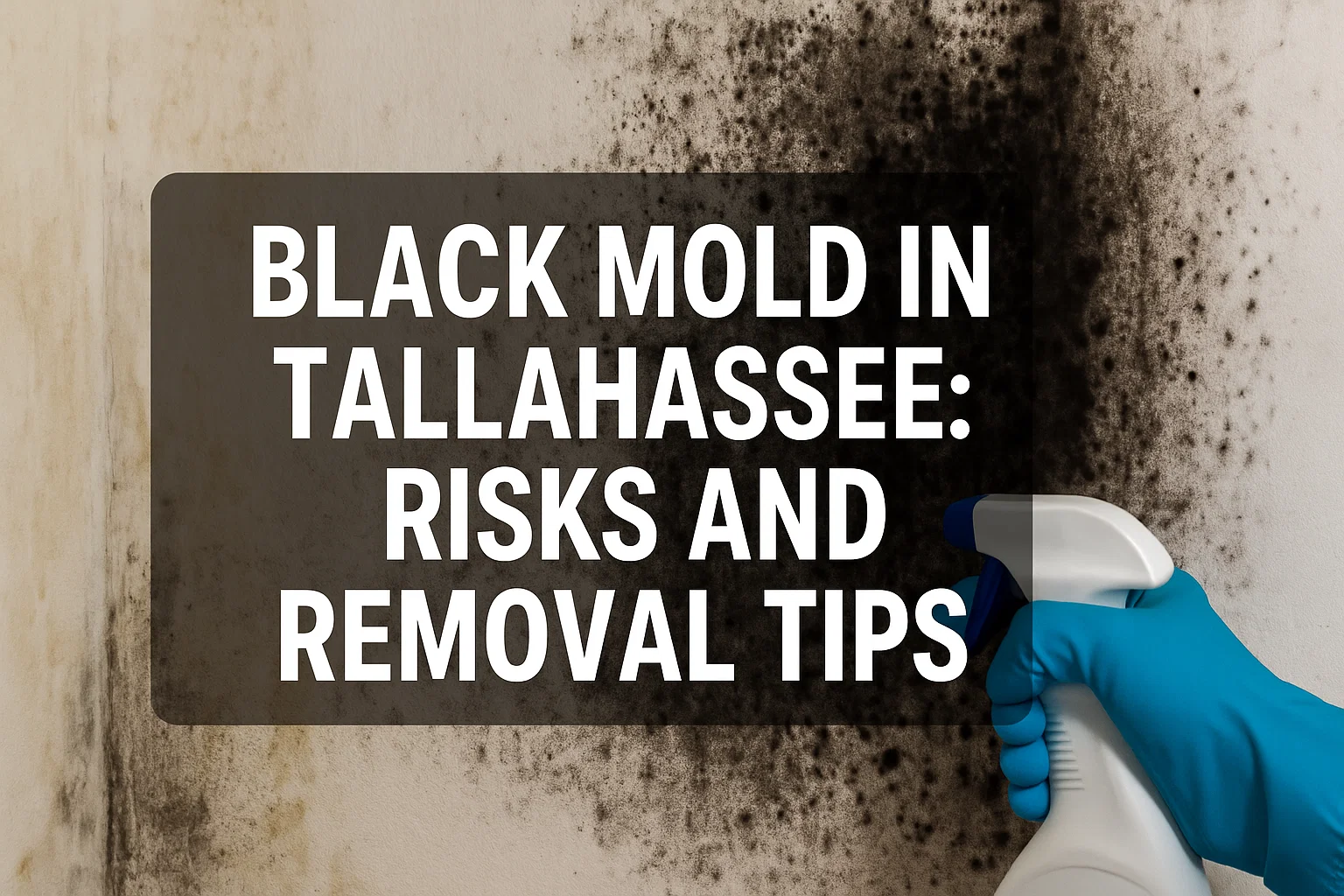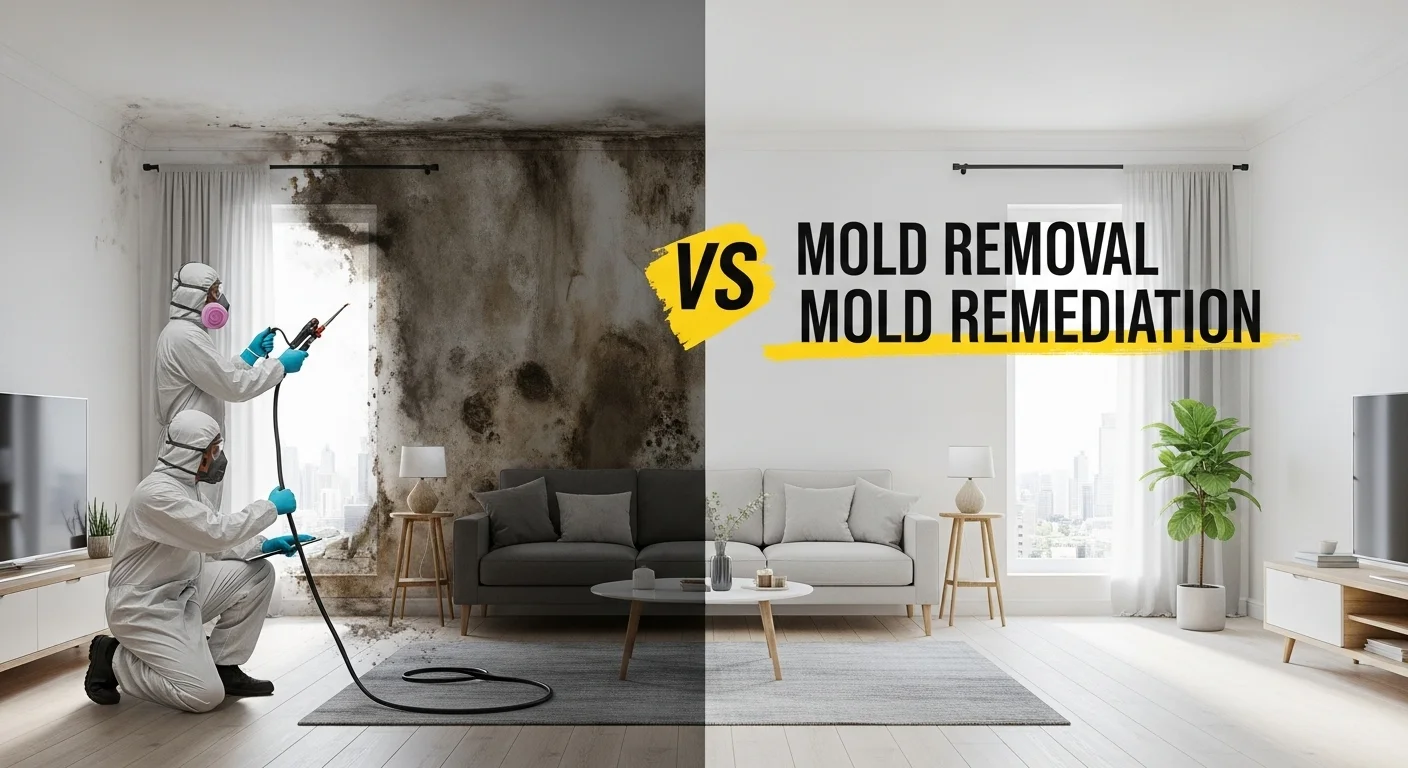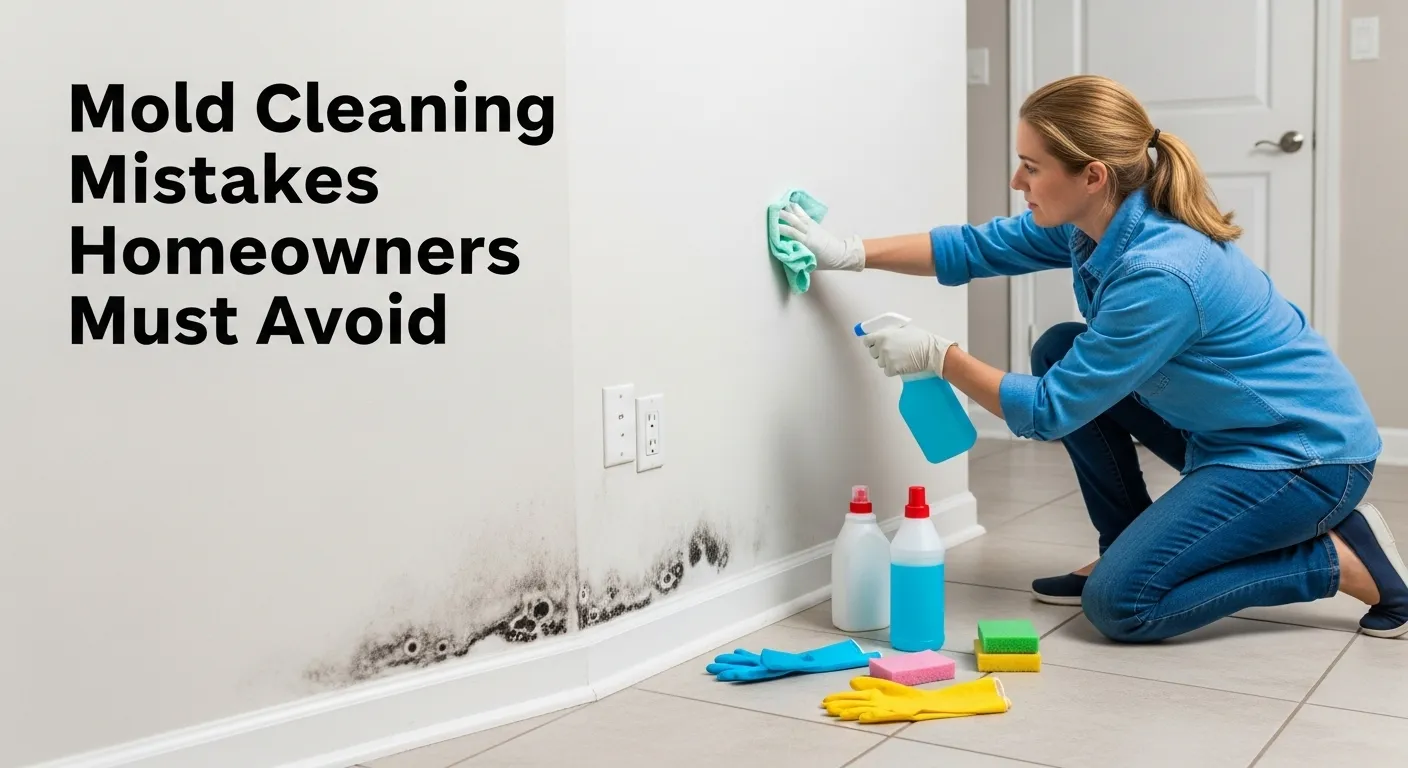Mold is a common problem in many homes, often lurking in hidden corners and behind walls where it can silently cause damage and health issues. Mold can spread quickly, leading to costly repairs and serious health concerns. This step-by-step mold inspection checklist will help you to detect mold early, identify potential risks, and take appropriate action to prevent further damage.
1. Understanding the Signs of Mold
Recognizing the early warning signs can help you address the issue before it becomes a bigger problem. Here’s how you can identify mold early in your home.

Musty or Earthy Odors
Mold has a distinct smell. It’s often described as musty, earthy, or damp. If you notice this persistent odor, it’s a strong sign that mold could be growing somewhere nearby, even if you can’t see it.
Visual Clues
Mold appears in various colors. The most common colors include black, green, white, and orange. It often looks fuzzy or slimy, depending on its type.
Signs of Water Damage
Mold thrives in moist conditions, often linked to water damage. Look for these telltale signs around your home:
Health Symptoms Caused by Mold Exposure
Mold isn’t just a home repair issue; it can also affect your health. The most common symptoms include:
2. Mold-Prone Areas to Inspect Indoors
Mold can thrive in hidden areas of your home, especially in places where moisture accumulates. Regular inspections of these spots can help you catch mold early and prevent further damage. Here are the key areas to check.
1) Bathrooms
Bathrooms are one of the most common places mold grows due to constant exposure to water. Be sure to check under sinks and around plumbing for any leaks or excess moisture. Tubs, showers, and grout lines are other prime spots where mold can accumulate. Additionally, ensure that exhaust fans are working properly to reduce moisture levels in the bathroom.
2) Kitchens
The kitchen is another high-risk area, as it involves water usage and food storage. Look carefully under and behind sinks, refrigerators, and dishwashers, as these areas are prone to water leaks. Inspect plumbing connections and seams where water might accumulate, providing the perfect environment for mold to grow.
3) Basements and Crawl Spaces
Basements and crawl spaces are typically damp and poorly ventilated, creating ideal conditions for mold. Moisture-prone corners, insulation, and areas near sump pumps are all spots that need thorough inspection. If you store boxes or wood in these areas, make sure to check them for any signs of mold growth, as these materials can absorb moisture and harbor mold.
4) Attics
Attics also often suffer from poor ventilation and roof leaks, making them prone to mold. Look for any signs of water damage, particularly in the insulation, and check for proper airflow. Condensation on rafters is another indication of moisture buildup that could lead to mold growth if not addressed.
5) Ceilings (Stains & Discoloration)
Ceilings are one of the first places water damage becomes visible. Look for stains or discoloration, which are signs of leaks. Bubbling or sagging paint on the ceiling often indicates that water has entered the structure, potentially causing mold to grow behind the walls or ceiling.
6) Window Frames and Sills
Moisture can accumulate around windows, especially if the seals are compromised. Check for condensation buildup on window sills, as it can promote mold growth. Also, inspect the caulking around window frames—cracks or missing caulking can allow moisture to seep in, increasing the risk of mold.
7) Roof Penetrations (Chimneys, Vents, Skylights)
Roof penetrations, such as chimneys, vents, and skylights, are common entry points for moisture. Check these areas for leaks or moisture buildup, as they can lead to mold growth around the edges and into your home’s interior.
8) HVAC Systems and Ductwork
Your HVAC system can spread mold spores throughout your home if not properly maintained. Musty odors coming from the vents are a sign that mold could be present. Additionally, check for stagnant water in drip pans, which can encourage mold growth if left unchecked. Clean coils and ducts regularly to ensure your system is mold-free.
3. Controlling Sources of Indoor Moisture
Moisture is one of the main contributors to mold growth in homes. Controlling moisture levels is key to preventing mold from taking hold. Here’s how you can manage indoor moisture to keep your home safe and healthy.
Household Habits That Increase Moisture
Certain household habits can unintentionally raise moisture levels. For instance, drying clothes indoors without proper ventilation can increase humidity, making it easier for mold to thrive. Cooking without using exhaust fans or leaving bathroom doors closed while showering also traps moisture in the air. Be mindful of these habits and try to adjust them to reduce moisture buildup.
Moisture from Appliances
Appliances like dishwashers, refrigerators, and washing machines can leak water or release moisture into the air. Over time, even small leaks can lead to significant moisture problems. Make sure to regularly inspect your appliances for leaks or signs of water damage. Use appliances properly to avoid water accumulation, and ensure that vents or drains are working efficiently.
Detecting and Repairing Leaks
Leaks are one of the most common causes of excess moisture. Water leaks can come from plumbing, roofs, windows, or even walls. Regularly inspect pipes, faucets, and the roof for any signs of leaks. Check areas around windows for water seepage and ensure that your home’s foundation is intact. Repair leaks immediately to prevent water from creating a breeding ground for mold.
Improving Ventilation
Proper ventilation is essential in controlling indoor moisture levels. Ensure that your home is well-ventilated by using exhaust fans in the kitchen and bathroom. Open windows when possible to allow fresh air to circulate, especially during activities that generate moisture, like cooking or showering. Consider using dehumidifiers in areas like basements or bathrooms, where humidity levels tend to rise, to keep moisture in check.
4. Outdoor Areas to Inspect for Mold Prevention
Mold doesn’t just grow indoors; it can spread from the outside too. Here’s where to focus your attention outdoors.
Outdoor Faucets and Hose Bibs
Outdoor faucets and hose bibs can be a source of moisture if not properly maintained. Check for leaks around these areas, especially after using the hoses. Even a small, constant drip can create a moist environment where mold can thrive. Ensure the faucets are tightly sealed, and inspect any hoses for damage.
Sprinkler Systems and Irrigation
Sprinkler systems and irrigation can add unnecessary moisture to your yard and home’s foundation if not properly directed. Check sprinkler heads to ensure they’re not spraying directly onto the walls or foundation. Also, inspect the irrigation lines for leaks, as these can cause soil saturation and potential mold issues around the exterior of the home.
Roof and Gutters
A well-maintained roof is critical to preventing moisture from entering your home. Inspect the roof for missing or damaged shingles that may allow water to seep in. Clogged gutters are another common problem—water that overflows from gutters can cause mold growth along the roofline and walls. Clean gutters regularly to ensure proper drainage.
Foundation Drainage
The foundation of your home must have proper drainage to avoid water accumulation around the base. Ensure that the ground around the foundation slopes away from the house, allowing water to flow freely. Inspect for any pooling of water around the foundation, which can lead to moisture entering the basement or crawl space, promoting mold growth.
Doors and Windows
Outdoor doors and windows are vulnerable to moisture infiltration, especially during heavy rain. Check for leaks around the door frames and window seals, as these areas can let in water, leading to mold problems inside. Make sure the seals are intact, and consider adding weatherstripping to reduce moisture entry.
Central AC and Drain Lines
Central air conditioning units can be a significant source of moisture if the drain lines are clogged. Water buildup around the unit can create conditions ripe for mold growth. Regularly inspect the drain lines to ensure they are clear and allow moisture to exit properly. Keep the area around the AC unit dry to avoid mold formation.
5. Use the Right Tools and Gear
When inspecting mold, it’s important to prioritize your safety. Mold spores can be harmful to your health, so using the right protective gear and tools ensures you can conduct the inspection safely and effectively. Here’s what you need.
6. Document Everything: Capture Your Key Insights
Thorough documentation is a crucial part of any mold inspection. By recording your findings, you create a clear record of potential issues, which can help if you need professional help later. It also allows you to track changes and monitor progress. Here’s how to document your inspection effectively.
Start by taking detailed notes as you go through your home. Write down any areas where you find visible mold, signs of moisture, or water damage. It’s important to note the size of the affected area, as larger mold infestations may require professional remediation. Include the exact locations of the problem areas, such as specific rooms, corners, or walls, to make it easier to reference later.
Photographs are essential for a thorough record. Use your phone or a camera to take clear, high-quality pictures of mold, water stains, or any damage. If you can, photograph the affected areas from different angles to give a complete view. Ensure that photos capture the scale of the problem, showing both the affected area and the surrounding environment.
This checklist will guide you through the key areas to inspect and help you track the condition of each. Whether you use a physical checklist or a digital one, it serves as a reliable tool to ensure that you don’t miss any important spots.
7. Conduct a DIY Mold Test
While a visual inspection is essential, sometimes mold is hidden from view. In these cases, a DIY mold test kit can help you confirm the presence of mold and measure its extent. You should consider using a mold test kit when you notice musty odors or signs of water damage, but mold is not visible.
These kits can detect mold spores in the air or on surfaces that may be too small or hidden to spot with the naked eye. They are also useful if you’re concerned about mold in areas like air ducts, behind walls, or in attics where you can’t visually inspect easily.
8. When to Call Mold Remediation Professionals
If mold is covering a large area, more than 10 square feet, it’s time to seek professional help. Mold growth of this size typically means the infestation is more extensive, and cleaning it yourself may not effectively remove all of it. Additionally, hidden mold, which can grow inside walls, attics, or under floors, may be present. This mold is harder to detect and requires specialized equipment to identify and remove.
Final Verdict
Mold is a common problem in many homes, especially in areas with high humidity or frequent water exposure. Identifying and addressing mold early is essential to preventing damage to your home and protecting the health of your family. By understanding the signs of mold, inspecting key areas, and taking proactive steps to control moisture, you can effectively prevent mold growth.
For minor mold issues, DIY solutions like cleaning with safe, natural products can be sufficient. However, if mold covers large areas, is hidden, or if you suspect toxic mold, professional remediation should be preferred.
FAQs
Is mold dangerous to health?
Yes, mold can be dangerous to health, especially if you are exposed to it for extended periods. Mold spores can cause allergic reactions, respiratory problems, and aggravate asthma or other pre-existing health conditions. Toxic mold types, such as black mold, can be particularly harmful, leading to more severe symptoms like headaches, fatigue, and memory issues.
Can bleach remove mold?
Bleach can remove mold from non-porous surfaces like tiles, glass, or countertops. However, it doesn’t penetrate porous materials like wood or drywall, so mold may return. While bleach can help disinfect the surface, it doesn’t address the root cause, such as underlying moisture, which is necessary for mold prevention.
How do I prevent mold in the bathroom?
To prevent mold in the bathroom, ensure proper ventilation by using exhaust fans. Keep the bathroom dry by wiping down surfaces after showering, using a dehumidifier, and fixing any leaks in pipes, faucets, or the shower. Regularly clean grout lines and caulking, and consider using mold-resistant paint on bathroom walls.
How often should I inspect for mold?
Inspect your home for mold at least once every 6 months or more frequently if you notice signs of water damage, musty odors, or humidity levels above 60%. Areas prone to moisture, like bathrooms, kitchens, basements, and attics, should be checked more often.
Will mold return after cleaning?
If you address the root cause of the moisture and remove mold properly, it shouldn’t return. However, if the underlying moisture problem (such as leaks or high humidity) isn’t fixed, mold can reappear. It’s essential to ensure proper ventilation, fix leaks, and control humidity to prevent mold from coming back.
What’s the ideal humidity level to prevent mold?
The ideal humidity level to prevent mold growth is below 60%. Keeping your indoor humidity between 30% and 50% is optimal for mold prevention. You can use a hygrometer to measure indoor humidity and a dehumidifier to control it.
Are DIY mold tests reliable?
DIY mold test kits can provide some insight, but they may not be as accurate as professional testing. They are useful for initial detection, especially when mold is hidden, but they may not identify all types of mold or assess the extent of the problem. For a comprehensive evaluation, it’s best to consult a professional mold inspector.
Should I buy a house with mold issues?
Buying a house with mold issues is not recommended unless you’re prepared for expensive remediation and repairs. Mold can damage the structure, and if not properly addressed, it can reappear. Make sure to get a thorough inspection and consider the cost of mold removal before making a decision.
Do air purifiers help control mold?
Air purifiers with HEPA filters can help reduce the concentration of airborne mold spores, improving air quality in your home. However, they won’t address the root cause of mold growth, which is excess moisture. To effectively prevent mold, you must control humidity and address any leaks or water damage.
How can I tell if mold is behind my walls?
Signs of mold behind walls include musty odors, discoloration or stains on walls or ceilings, and visible damage like bubbling or warping. If you suspect hidden mold, you can use a moisture meter or hire a professional to inspect the area with an infrared camera to detect moisture or mold growth behind the walls.






